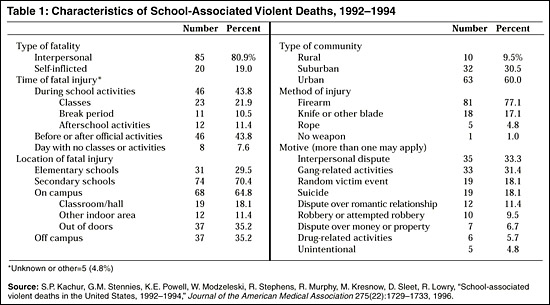|
Weapons Carrying weapons to school has become an acceptable risk for many students, both those who are fearful and those who intend to exploit others. Underlying the reasons students bring weapons to school may be the societal attitude that violence is an effective way to deal with problems. Television and movies depict violence as an effective problem-solving technique used by "good guys" and "bad guys" alike. Regardless of whether weapons are used in an act of aggression or as a defense against another's aggression, the reason weapons are brought to school often is related to the proliferation of gangs and drug activity on or near many school campuses. A weapon is any instrument used with intent to inflict physical or mental harm on another person. Although school officials are concerned with all weapons, knives, guns, and explosive devices present the greatest threat to school safety. Weapons have been found and used on school campuses nationwide. Of the 3,370 high school students surveyed in the 1996 Twenty-Seventh Annual Survey of High Achievers, 29 percent reported that they knew someone who had brought a weapon to school, and 17 percent claimed it was not very difficult to obtain weapons at school.20 When looking at the prevalence of gun possession in particular, the 1995 School Crime Supplement to the National Crime Victimization Survey found that 12.7 percent of student respondents knew someone who brought a gun to school.21 According to the same study, the percentage of students reporting this increased as their age increased (see figure 1).
 A periodic survey conducted by the Centers for Disease Control and Prevention (CDC) reported that nearly 12 percent of the polled students in grades 9 through 12 carried a weapon on school property during the 30 days preceding the survey, and 7.3 percent were threatened or injured with a weapon on school property during the 12 months preceding the survey.22 In a study measuring school-associated violent deaths from 1992-1994, 77 percent of the deaths were due to firearms (see table 1).23
 Startlingly, the cost of a death due to a single 22-cent, 9-millimeter bullet has been documented as including the following expenses: juvenile hall and jail costs for 1 year for four suspects, $85,710; a 2-week trial, $61,000; crime scene investigation, $13,438; medical treatment, $4,950; autopsy, $2,804; and State incarceration costs if the four suspects are convicted and serve 20 years, $1,796,625 -- for a grand total of $1,964,527.24 Extrapolated costs in terms of lives cut short and loved ones' grief, lost potential and productivity, and resulting damage to the Nation's psyche and society are inestimable, but nonetheless real. Examples of strategies being implemented to prevent or intervene in the use of weapons in schools include:
| ||||||||||||||||||||||||||||
